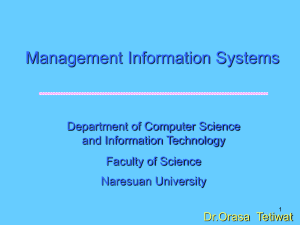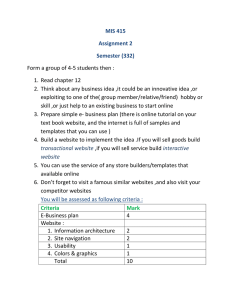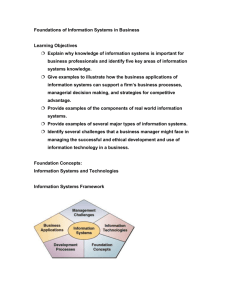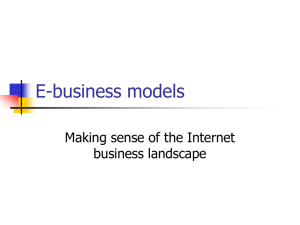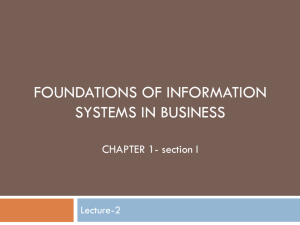innovation management
advertisement
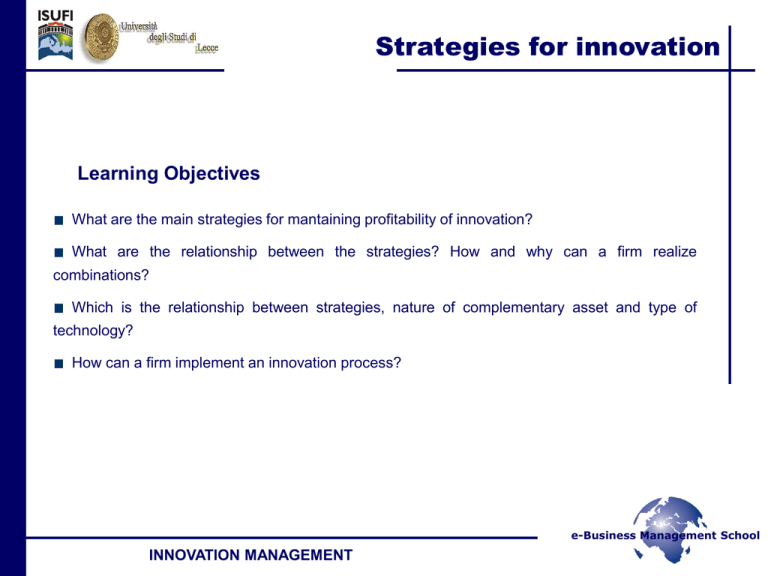
Strategies for innovation Learning Objectives What are the main strategies for mantaining profitability of innovation? What are the relationship between the strategies? How and why can a firm realize combinations? Which is the relationship between strategies, nature of complementary asset and type of technology? How can a firm implement an innovation process? e-Business Management School INNOVATION MANAGEMENT Strategies for innovation Strategies for innovation Learning contents The Block Strategy; The Run Strategy; The Team-Up Strategy; The condition under which a firm can combine the three strategies; The types of technology and the nature of complemetary assets that influence the choice of a combination of the three strategy. e-Business Management School INNOVATION MANAGEMENT Strategies for innovation Strategies for sustaining profits The firm’s profit froms an innovation is usually only temporary. As an incunbent or a new entrant an innovator can prolog the time over which it can keep profits choosing one or more of the following strategies: The chooice of block, run or team up strategy at any stage of the value chain is a function of several factors: Block • The firm’s capabilities • Its type of product or service •The phase of the evolution of innovation • Its strategy Run •Capabilities •Product or industries •Life cycle phase •Firm strategy Team-up e-Business Management School INNOVATION MANAGEMENT Strategies for innovation Strategies for sustaining profits: Block This strategy allow a firm to provent entry by competitors By limiting the competitors’ access to inimitable and coreness capabilities By signaling the competitors that post-entry price will be low e-Business Management School INNOVATION MANAGEMENT Strategies for innovation Strategies for sustaining profits: Block The effectiveness of a firm in blocking entry to any stage of the value chain is a function of how unique and inimitable its competences and assets and are at that stage. At the development level, intellectual property protection can make very difficult for new entrants to offer designs that are comparable to those of incumbents At the research stage, close relationship with universities can provide fast access to scientific research findings At the manufacturing stage, example of endowments that a firm can use to prevent entry are exclusive access to certain inputs, licenses that allow to manufacture product at lower cost, ecc. e-Business Management School INNOVATION MANAGEMENT Strategies for innovation Strategies for sustaining profits: Block If all firms are equally capable of performing the activities of each stage of the value chain and have equal access to the underlying technological and market knowledge then the block strategies is based on some signals that suggest to potential new entrant that post entry price will be low. Some of these signals are: Technology drivers and coshared resources: in the face of the introduction of an innovation in a market, an incumbent is likely to stay and fight if its existing technology also serves as a technology driver for its other products. Management committment to existing technology: if the management of a firm is committed to its existing tecnhnology the firm is not likely to take entry expecially if the technology is one of the major source of revenue of the firm. History of retailation: if an incumbent has an history of retaiiatiating against firms that have ventured into its product-market, that may be a signal that it will lower its prices with entry. High Minimum Efficient Scale for Industry: if the minimum volume that a firm has to produce in order to attain the minimum per unit cost possible in the industry is large, entrant are less likely to enter since they can expect to drop considerably, given how much they have to add to the industry’s capacity. Idiosyncratic asset: an asset is idiosyncratic to a market if is of litte value in another market. If an incumbent invests in such assets, it is sending a signal to potential entrants that it can lower its prices post entry. e-Business Management School INNOVATION MANAGEMENT Strategies for innovation Strategies for sustaining profits: Run This strategy is base don the evidence of the rapidity of the innovation process. A firm must be innovative enogh to build new capabilities and introduce new product rapidly and do so well ahead of competitors We can classify run as a function of their inpact on the capabilities of the firm in question and the extent to which the run cannibalizes existing product. Obsolescence of existing capabilities Product cannibalization Low High High Type III e.g.: Microwave oven Type II e.g.: Apple Macintosh Low Type IV e.g.: Shrink of Pentium Type I e.g.: Pentium e-Business Management School INNOVATION MANAGEMENT Strategies for innovation Strategies for sustaining profits: Team-up In a team-up strategy a firm formally cooperates with others to allow it to keep profiting from innovation. This cooperation can be in the form of a strategic alliance, an acquisition or another agreements to cooperate in adding value in a firm’ s value-creating activities The type of collaborations are: Strategic alliances Distribution agreements Venture capital Co-marketing agreements Acquisitions Technology agreements Join ventures Design agreements Licensing Manufacturing agreements e-Business Management School INNOVATION MANAGEMENT Strategies for innovation Strategies for sustaining profits: Team-up There are five reasons why a firm might want to give away its technology: 1. To win a standard or dominant design: making a design open invites other firms to enter the market using it increment of manifacture of the design more complementary innovators more commitments to developing complementary products for it. 2. To increase upstream demand: a firm can give away its technology downstream to increase demand for its product upstream. 3. To build capabilities: very often a firm has to license its innovation to competitors so that it can build competences in an area in which it lacks such capabilities. 4. To exploit the second source effect: some customers are reclutant to incorporate a component in their system unless they are sure that compatible generations of the component will be forthcoming when they need them. 5. To access to a market that would otherwise be inaccessible: sometime a firm have to team-up with a firm in a foreign country so as to enter that market. e-Business Management School INNOVATION MANAGEMENT Strategies for innovation Relationship between the three strategies Block •Capabilities •Product or industries •Life cycle phase •Firm strategy Run Team-up They all rest on competences and endowements as well as on the underlying technological and market knowledge. The three strategies can be reinforcing and corroborating A firm ability to joggle all three in the face of the technological change, deregulation or regulation, changing customer preferences and expectations, and global competition is critical to mantaining entrepreneurial rents e-Business Management School INNOVATION MANAGEMENT Strategies for innovation Relationship between the three strategies: Why combinations Secondary strategy Block Block Run Main strategy Run Team-up While fithing imitation of its innovation by blocking competitors, a firm can run developing new product generations to cannibalize existing ones. Advantage secured through blocking last only until such regulation, deregulation and changing in customer preferences render them obsolete the firm have to team-up to exploit technologies and markets that are unfamiliar. In that industries in which new product development is very expensive a firm can use Blocks to slow down competitors enough to introduce new products. Where the Run involves radically different technological and market knowledge unfamiliar to the firm, it may need to form alliances. Team-up After a firm wins a standard through an alliance, it must still do something distinctive that allows it to perform better than the members of its team. e-Business Management School INNOVATION MANAGEMENT Strategies for innovation Relationship between the three strategies: When combinations Combinations along the value chain A firm would successfully run or block or team up only at those stages of its value chain where it has the capabilities to underpin each strategy e-Business Management School INNOVATION MANAGEMENT Strategies for innovation Relationship between the three strategies Value chain activities Combinations along the value chain: Dell Computer Example Idea Generation Supply chain Production Distribution Marketing & Sells Block Strategies Team up Run Team up Block Run Team up Run e-Business Management School INNOVATION MANAGEMENT Strategies for innovation Relationship between the three strategies: When combinations Combinations over Innovation Life Cycle The strategies that a firm pursues over the life cycle of a technology also vary Following the emergence of the dominant design the firm may want to introduce versions of the design more frequently (run) than its competitors. It may also want to defend its intellectual property or brand name reputation (block) During the phase of development of a new product, an innovator can team-up to win the dominant design. At a discontinuity, the type of strategy pursue depend on the nature of the discontinuity: Competence enhancing run, block or both Competence destroying team-up e-Business Management School INNOVATION MANAGEMENT Strategies for innovation Relationship between the three strategies Type of technology and nature of complemetary assets The type of strategy that a firm pursues at any phase of a technology life cycle, is also a function of the imitability of technology and nature of the complementary assets needed to profit. Cell I When imitability of the technology is high a firm can pursue a run strategy; a firm can keep innovating so that the time competitors catch up with yesterday’s technology, it has moved on to tomorrow’s technology. Sometimes, a firm may need to team up in order to run. Cell II The firm must develop the complementary assets internally (run) or get them by teaming up with someone else. Cell III Cell IV When thechnology is difficult to imitate but complementary assets are easy to come by, a firm can pursue a block strategy in order to protect that technology. A firm can also pursue a run strategy to allow it to stay ahead of its competitors. If a firm has both the technology and the complementary asset, it can pursue block stretegy in order to protect both. If technology becames obsolete, the firm must team up with someone that have a new technology. e-Business Management School INNOVATION MANAGEMENT Strategies for innovation Relationship between the three strategies Internal development or external sourcing Firms that pursue a team up strategy go outside thier boundaries for some of the capabilities that they need to exploit the technology. Whether a firm decides to develop a technology internally or go outside for help is also a function of two factors: 1. The firm’s familiarity with the new technology and market; 2. Transaction costs. e-Business Management School INNOVATION MANAGEMENT Strategies for innovation Relationship between the three strategies Internal development or external sourcing 1. Familiarity of the new technology and market The more the technological and market capabilities need to exploit an innovation differ from a firm’s existing capabilities, the more likely the firm will fail in trying to exploit the innovation. Since building these capabilities is often difficult and takes time, a firm may be better off teaming up with another firm that has them Such co-operation allows the firm to learn from its partner and develop its own capabilities or co-develop capabilities for joint use. e-Business Management School INNOVATION MANAGEMENT Strategies for innovation Relationship between the three strategies Internal development or external sourcing 1. Familiarity of the new technology and market Cell I The firm brings technological capabilities to the table while the partner bring market capabilities and both companies can form a joint venture to exploit the new technology. Cell II When innovation is competence destroying a firm can pursue one of the three options to learn and build the new capabilities while not being handicapped by the existing ones. Cell III A firm that faces an unfamiliar new technology but has the market capabilities can licence the technology from another firm. An important precaution is to make sure that the licence has the absorptive capacity to successfully trasfer the technology. Cell IV Internal development is preferred in three cases: 1. When the technological change is competence enhancing or incremental; 2. When the firm is not in a rush; 3. When the firm want to protect its technology. INNOVATION MANAGEMENT e-Business Management School Strategies for innovation Relationship between the three strategies Internal development or external sourcing 2. Transaction costs Transaction costs theory suggest that whether a firm organizes activity internally or externally is a function of the cost of carrying out the activity in either mode. These costs depend on four factors: The frequency of transactions The amount of uncertainty How opportunistic the parties are The asset specificity of any assets used in the activity e-Business Management School INNOVATION MANAGEMENT Strategies for innovation Relationship between the three strategies Internal development or external sourcing 2. Transaction costs Opportunism of the parties A party is opportunistic if it take advantage of an information asymmetry and cheats in pursuing its own ends: the more uncertainty information that is needed, the more easy is to create room for opportunism. The chances to exercise opportunism are also a function of asset specificity Asset specificity Asset specificity refers to how idiosyncratic an asset in a relationship becomes as the relationship develops. Frequency of transaction Frequency of transaction is how often the transaction between the perties must take place: the higher the asset specificity and the frequency of transactions, the more chances there are for opportunism. e-Business Management School INNOVATION MANAGEMENT Strategies for innovation Relationship between the three strategies Internal development or external sourcing 2. Transaction costs Opportunism is not the only source of transaction cost Since individuals are cognitively limited, a party to a transaction may be not be able to articulate the information it has. Even if the party could articulate it, the other party may not be able to understanding it. For certain type of informations, transaction costs may be high even when the parties are not opportunistic Innovation often requires specialized plants and individuals, increasing the chances for opportunism. Radical innovation has the qualities that would suggest internalization to minimize transaction costs. It may be difficult to specify in contracts what is that expected from each party. If it fully of uncertainty and leaves a lot of room for opportunism. e-Business Management School INNOVATION MANAGEMENT
